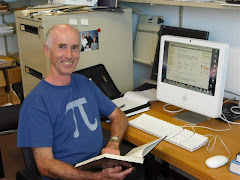
A very interesting talk on ‘The Evolution of Medieval Manuscripts’ was given by Christopher Howe from Cambridge University, UK. He described how techniques that have been developed to reconstruct the evolutionary relationships from DNA sequence data have been applied to medieval manuscripts to get relationships between different versions of a text and reconstruct their copying history. The added complication of a scribe using more than one copy in copying a text has parallels to lateral gene transfer. The conclusions reached from the computer programs seem to agree with those from conventional analysis.
There were three speakers from USA who are involved in the use of mathematics and computer science in biology education, Holly Gaff, John Jungck and Tony Weisstein.
Holly Gaff, in her talk ‘Teaching the Biology and Ecology of Infectious Diseases through Mathematics’ pointed out the value of mathematical modelling to assess the potential spread of disease (without running actual trials!) and trying to predict the best practices for prevention and control. She illustrated the modelling of vector-borne diseases (e.g. via the mosquito) and the problem of genetic modification of pathogens.
Holly is involved in a project developing a high school (secondary) maths-biology curriculum. http://dimacs.rutgers.edu/BMC/
John Jungck’s talk in the ‘Towards Biology 2020’ theme of BioEd concerned the importance for students to be involved in conducting investigations and the increasing need for quantitative analysis – he listed calculus, discrete mathematics and statistics as the key areas of maths. Important applications mentioned included those from medicine, agriculture and environmentalism.
In 1997, John published a paper entitled ‘Ten Equations that Changed Biology: Mathematics in Problem-Solving Biology Curricula’ in which he argues the importance of mathematics in undergraduate biology education and draws attention to a variety of mathematical models that have been intrinsic to many of the significant discoveries in biology in the 20th century. These encompass evolution, genetics, developmental biology, biochemistry, cellular and molecular biophysics, and population biology.
Ten Equations that Changed Biology: Mathematics in Problem-Solving Biology Curricula
Tony Weisstein introduced Excel-based simulations of population genetics which he (along with John Jungck and others) has been involved in developing to support a multi-disciplinary approach to learning (mathematics, biology and computer science).
Their downloadable ESTEEM modules can be found at
http://bioquest.org/esteem
Two of the presenters were from Canterbury University’s Biomathematics Research Centre:
Charles Semple presented some of the mathematical difficulties involved in trying to reconstruct evolutionary trees and the search for methods that can reduce computer time. He gave an introduction to some notable problems in the area: the unrooted supertree problem, the maximum parsimony problem and the reconciling gene trees problem.
Mike Steel outlined the importance of phylogenetics (e.g. understanding evolutionary processes, biodiversity conservation and epidemiology) and the need for mathematics.
He suggested the type of mathematical skills that are likely to be most useful for future students wishing to work in this area, namely:
· Discrete maths (graph theory, algorithms, etc.),
· Probability (discrete markov chains, branching processes, etc.)
· Algebra and calculus (linear algebra, discrete Fourier analysis, modelling with DE’s).
At the end of his talk, Mike made reference to an essay written by Joel E. Cohen, Professor of Population at Rockefeller and Columbia Universities, New York, discussing ways each field can benefit from the other. It makes for very interesting reading:
Mathematics Is Biology's Next Microscope, Only Better; Biology Is Mathematics' Next Physics, Only Better
Susan Worner, from the Bio-Protection Research Centre at Lincoln University, gave a presentation on how evolutionary computing is helping in the battle to protect New Zealand from alien invasive species, such as the painted apple moth. Over 3000 insect pest invaders potentially could establish in NZ. Evolutionary computation used in phylogenetic studies can help identify which species are most threatening, where in the world they might come from and where they could establish a viable population. Computers can then be used to run various models of spread and control that can help scientists and authorities be better prepared.
I have become aware that there are a number of mathematicians working on biological problems in New Zealand, notably at the Allan Wilson Centre for Molecular Ecology and Evolution in Palmerston North, at Canterbury University, Auckland University and Massey University in Auckland, and I hope to have the opportunity to see what some of these mathematicians are doing later in the year.






.jpg)